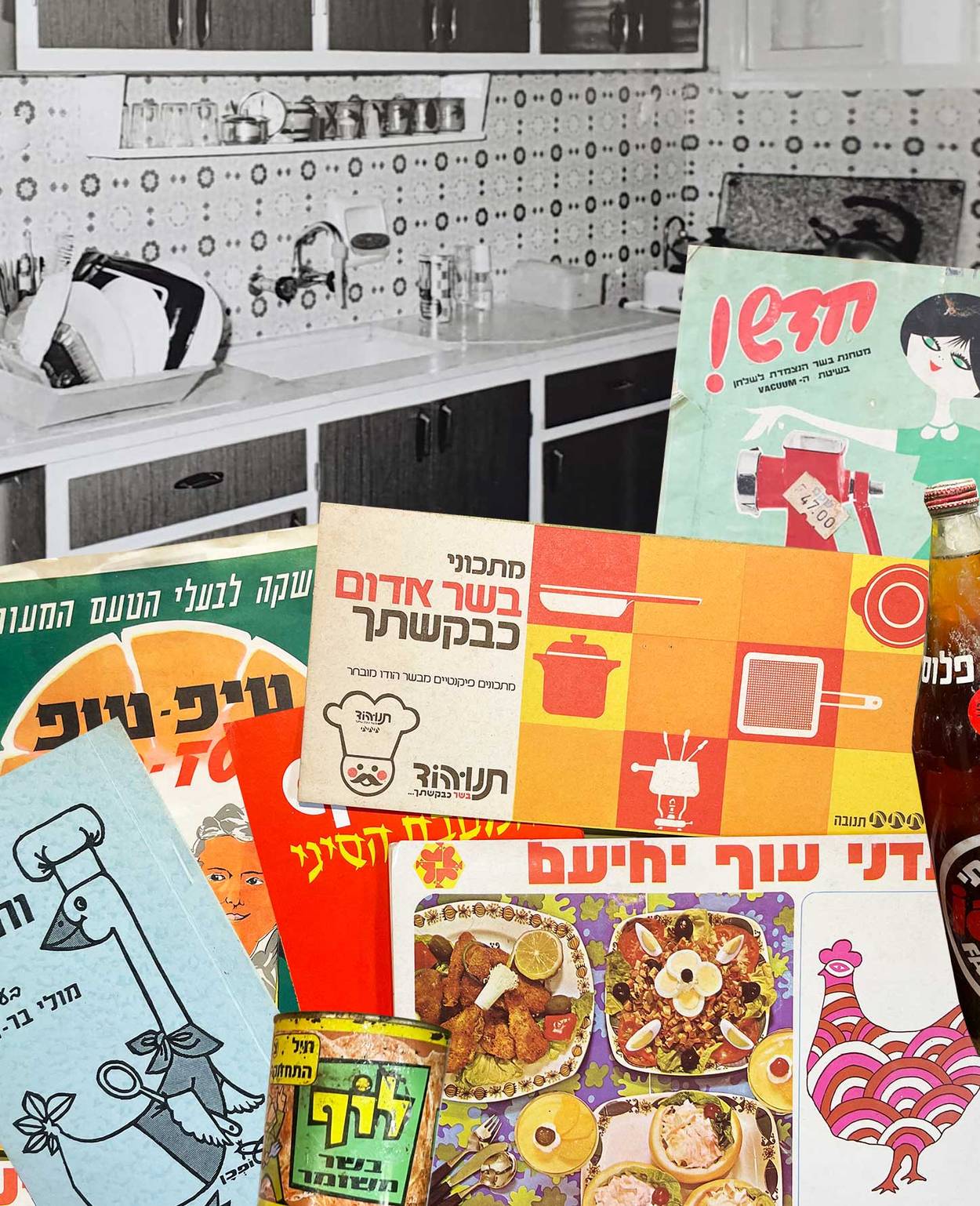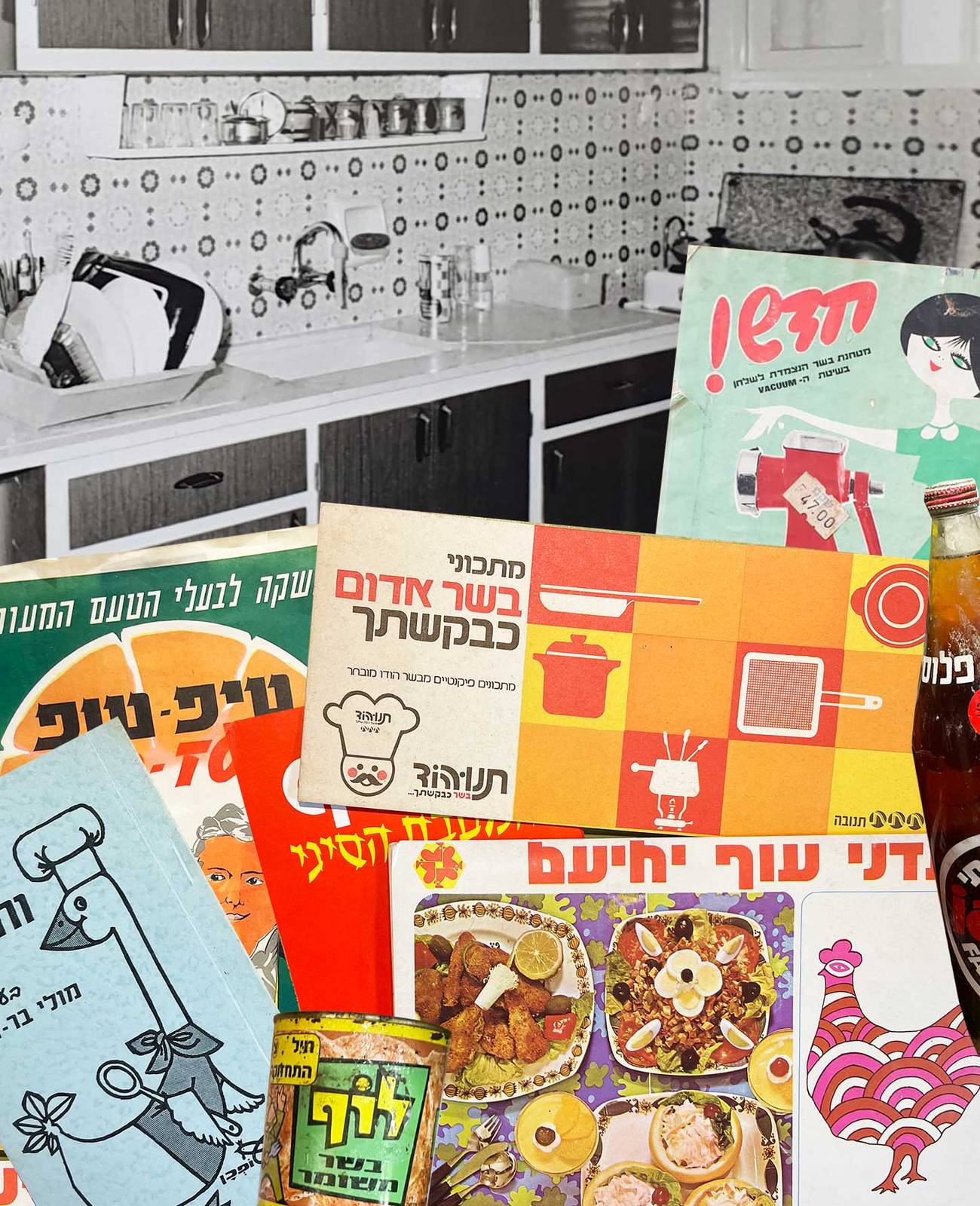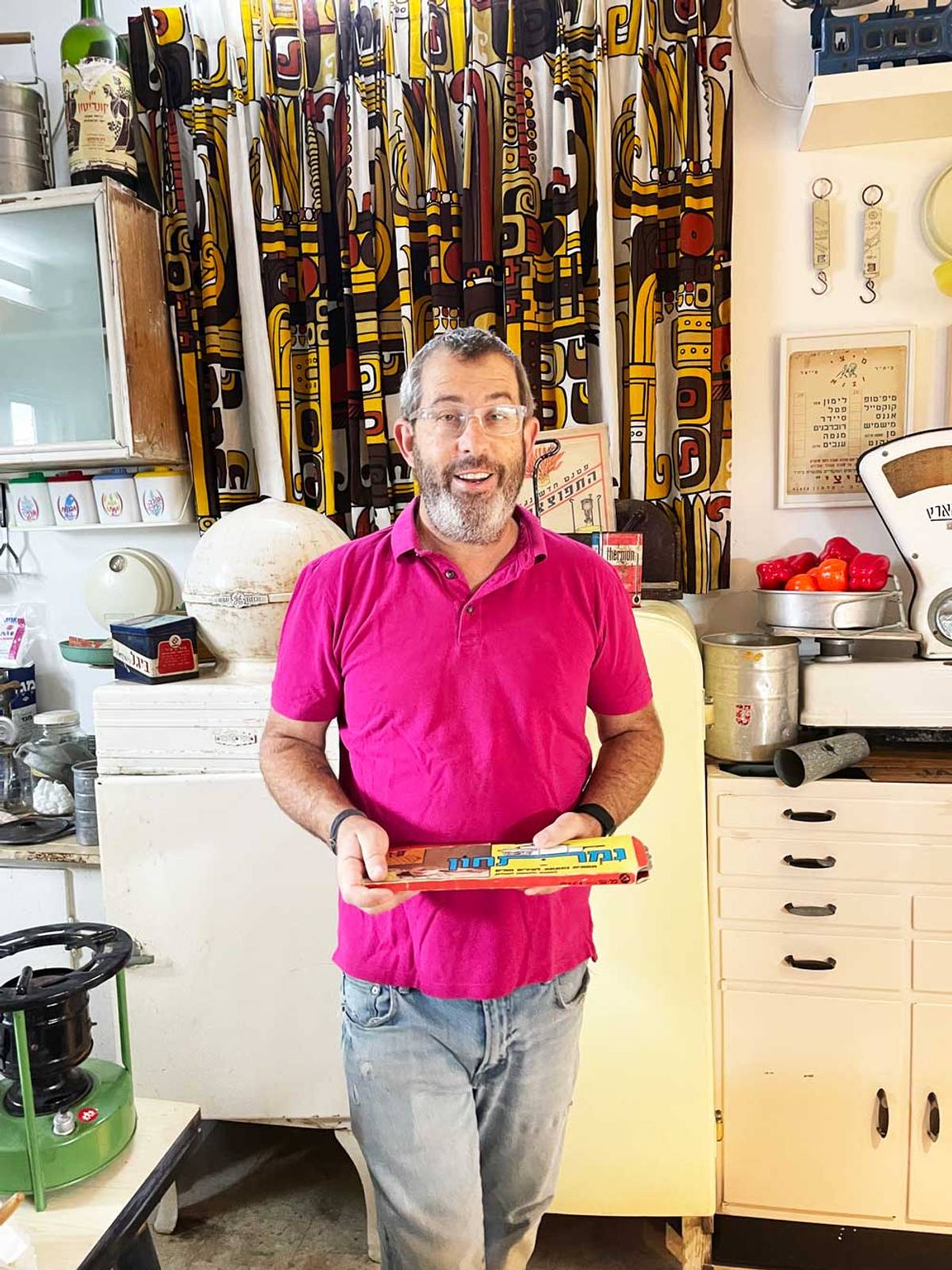The Kitchen of Yesterday—Today!
Vintage Israeli appliances, food packaging, and tableware, evoking a very specific period in the country’s history, are now fodder for museum exhibits




For Israelis, entering Ha-Tsrif—meaning The Shack—feels like stepping out of a time machine, somewhere in the past. This new, privately owned mini-museum, dedicated entirely to vintage Israeli kitchens and their contents, is a moving example of someone turning their life’s passion into creative entrepreneurship. Oded Zwickel’s “shack” is filled to the brim with kitchen appliances, tools and accessories, food packaging, tableware, and kitchen-related novelty items. Its walls are lined with real old kitchens from various periods—worktops, cabinets, sinks, refrigerators, etc.—as well as shelves with vintage Israeli cookbooks.
The place provides an ongoing sensory experience that conjures involuntary memories. It depends where in Israel, and especially when, you grew up, but any Israeli—or anyone from elsewhere who volunteered at a kibbutz or regularly visited family here many years ago—is going to experience quite a few flashbacks, like those stirred by the madeleines in Marcel Proust’s In Search of Lost Time.
When entering, you don’t know where to look first. You recognize relics from your childhood home, or from your grandparents’ house, which compel you to take pictures and WhatsApp them to everyone you know: “OMG!!! Do you remember this???” The feeling resembles opening a box of personal mementos: You see the plate you accidentally broke at your great-aunt’s birthday, the candy box with cherry liqueur-filled bonbons your mom used to tell you not to touch, the Loof tin cans from the army. (Loof is the Israeli version of Spam—the name a mispronunciation of the word meatloaf—which the IDF used to feed its soldiers until fairly recently, when it was finally deemed inedible.) Visiting the museum without having grown up in Israel, I’m sure, is a very different experience, but surely no less fascinating.
As the name implies, the museum is located in an actual shed in the garden of Zwickel’s home in Elyakhin. The locality is populated mostly by the original Yemenite settlers and their offspring, but in recent years, more and more Tel Avivi expats, like Zwickel and his girlfriend, started escaping the hustle and bustle and ever-increasing rent prices of the city for a quieter life in the Hefer Valley area. Zwickel used to own a fast-food sushi chain and later became a culinary adviser and helped entrepreneurs open and run their own food businesses. He also used his expertise to become culinary-producer on top Israeli cooking competition reality-TV shows. As a hobby, Zwickel has been collecting nostalgic culinary artifacts for more than 25 years.
His collection, accumulated from flea markets, yard sales, house clearances, and gifts, is all “made in Israel” between the establishment of the state until the 1980s. “I don’t collect things that were made later than the mid-1970s or ’80s, since by that time most things stopped being manufactured in the country,” he explained. “That’s when import started.”

Historic artifacts from before the birth of Israel are fascinating, too, of course, but that is a whole different story. Zwickel is mostly interested in the history of Israel since 1948. He loves, for instance, products that say la-kol—meaning “for everybody,” which were price-controlled. “The word la-kol was engraved or stamped on the product, usually inside a Star of David, with the controlled price,” he said. “I also love old appliances that still work, like my refrigerators, toasters from the 1950s, or Amcor electric mixers. I’m generally not impressed by how much a piece is worth. I can be really moved by something like an old rusty container of Osem soup powder from the 1940s or a bottle of a ’70s soft drink someone once found on the beach.”
A few months ago, Zwickel decided (well, his girlfriend decided) to move his vast collection into a shed in their garden. Friends who entered were so impressed and excited they immediately wanted to bring more people over, so Zwickel decided to open his very own museum and to host guided tours for groups of six to 24 people—at this point only in Hebrew. In addition to tours, he also started hosting nostalgic concept dinners, together with various guest chefs, based on the recipes of the high-priestesses of Israeli cooking, like Lilian Cornfeld, Erna Meyer, and Liora Zuckerman. “The idea is to prepare those old recipes from the classic cookbooks and make them work for today’s palate while retaining the original feel and look of the dishes,” he explained.
His regular tours also include refreshments, such as some kind of nostalgic soup (we got tomato soup with rice on a recent visit), coffee and tea made and served in unique vintage items, and gazoz made with carbonated water from a Sypholux—an original Israeli brand of refillable soda syphon bottles. As opposed to the heavy glass syphons that you had to take to the shop to get refilled, Sypholux bottles were made of metal and refilled at home with CO₂ cartridges. Refillable soda syphon bottles were invented in the U.S. in the 1930s, but the Sypholux brand, which was created in Tel Aviv in the 1950s, became a symbol of Israeliana—an increasingly popular term fashioned after the word Americana, which refers to Israeli cultural artifacts and memorabilia.
With its trademark design—a silver bottle with red stripes and a red head—the Sypholux had a slightly different mechanism from the original American version, and it became an extremely popular wedding gift. Young married couples in the 1960s, ’70s, and ’80s, usually ended up with quite a few superfluous Sypholuxes after their big day, which they then had to exchange (Zwickel tells me of a shop in Tel Aviv that would happily exchange anyone’s Sypholux) or—more commonly—simply regift.
For dessert we were served sponge cake baked in a Wonder Pot. Like Uri Zohar used to sing: Ha-rosh ha-yehudi mamtsi lanu patentim (“The yidishe kopf invents new tricks”). And one of these tricks is the Wonder Pot. Since I knew it by its German name, Wundertopf—as it was called in many Ashkenazi households—I always assumed it was invented in Germany. But it turns out that the aluminum pot with the hole in the middle is an original Israeli apparatus for baking on top of a gas stove, a wick, or a Primus, rather than in an oven. First manufactured by the Palalum company (the name is a portmanteau of Palestine and aluminum), established by industrialist Hillel Hillman in 1933 in Ramat Gan, the Wonder Pot was extremely popular during the austerity period in the ’50s, when most people didn’t have ovens, and was generally used until the late ’70s (and is still used today in the Haredi community).
Like the State of Israel itself, the contents of its kitchens—food-wise as well as in terms of tools and appliances—grew rapidly. In the beginning, the new state didn’t have enough to feed all of its immigrants, and imposed harsh economic policies, such as food rationing, which lasted from 1949 to ’59. Then, in the ’60s and ’70s, more and more products were manufactured and it was a time of groovy designs and Israeli pride. Many logos and packaging from those years boasted blue and white colors, and products were branded with original designs and Hebrew names that sound comically forced to today’s ears. “From the 1980s onward, the world opened up to us, and international trends started flowing in,” Zwickel said. “Some caught on and some didn’t.”
The kitchen itself also changed a lot over the years, said Gil Fanto, owner of another private museum of local nostalgia (not necessarily kitchen-related), Israel of Yesteryear, which he opened in Jaffa more than 10 years ago: “In the beginning there were built-in wood kitchens. These simple wood kitchens were the standard up until the mid-1960s. During the period of austerity, people didn’t own electric refrigerators. They had ice boxes and a person who sells ice blocks would pass on the street; there were also ice factories where you could buy the ice. People also didn’t have ovens; they cooked on a wick or Primus or a small gas stove which you place on your countertop.
“In the late ’60s and early ’70s,” Fanto continued, “kitchen cabinets were starting to be made out of Formica. The tiles that lined the wall between the lower and upper units of the kitchen also changed. The wood kitchens had simple white tiles, and when Formica entered the Israeli kitchen, so did colorful tiles and tiles with different designs. During the state’s early decades, the kitchen was something very functional, not something to brag about.Only later did the kitchen become a lifestyle thing. Israeli kitchens were also in a separate room until very late. Only in the 1990, the open-concept kitchen started entering the country.”
The question is what characterized the Israeli kitchen. “It is a result of the Kibbutz Galuyot—immigrants from different corners of the world,” Zwickel offered. “Both in terms of flavors and recipes, as well as in the operational aspect, like the types of appliances and utensils used. Most of them were copied from, or inspired by, items people used in the countries from which they came.The beauty is that Israel could have imported these things, but out of local patriotism, as well as the desire to drive the economy, Israel preferred to locally manufacture almost all kitchen items in its early decades.”
Fanto agrees: “What is special about the first 25 years of the country is that there were almost no imports. Everything was made in Israel, so almost everyone had the same things in the kitchen. These were local versions of things that are available abroad, with local designs.
“Another thing,” Fanto continued, “is that for many years, all products related to the home and the kitchen were marketed directly to women—specifically to the housewife. For example, I recently found a meat grinder from the ’70s in the market. The machine was called Tehan-Kal, meaning Easy Grind, and on the box was an illustration of a woman with the slogan (in Hebrew): ‘An asset to every wise housewife.’”
The wise housewife is also the one who needed convincing that it was time to move to an electric kitchen. “The Israeli housewife of the 1950s was used to working with an icebox and gas stove, and suddenly electrical appliances started popping up,” Fanto said. “So, the Israel Electric Corporation addressed the housewife directly, in the early 1960s, with the rhyming slogan: Yoter chashmal—pachot amal, meaning ‘More electricity, less work.’”
Some nonrenovated apartments in the country still have the old wood kitchen cabinets and many of the old Made-in-Israel products have gained new life as collectors’ items, but sadly the Israeli kitchen of today has no unique features and looks exactly like kitchens anywhere else. For most Israelis, a museum is now the only place to see what these kitchens used to look like.
Dana Kessler has written for Maariv, Haaretz, Yediot Aharonot, and other Israeli publications. She is based in Tel Aviv.